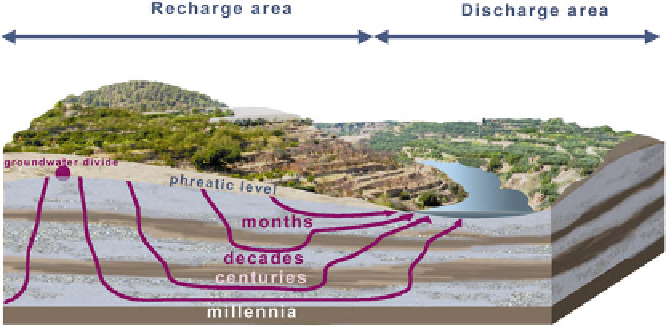Environmental Engineering Reference
In-Depth Information
Fig. 17.2
Recharge and discharge areas, flow lines and residence time of water in an aquifer, from
López-Geta et al. (
2006
; reproduced with permission)
It is expected that climate change will impact the hydrological cycle in the future,
both in terms of magnitude and in regularity of fluxes. Several scenarios have been
developed to predict the potential impact of climate change on the hydrological
regime. Although there is no general consensus on the quantitative effects, it is
widely accepted that many (semi-)arid areas will become drier, resulting in less
groundwater recharge. In humid zones, recharge might increase due to a higher
number of extreme precipitation events. Efforts are being undertaken so as to better
understand the climate change mechanisms on a regional and even local scale, and
hence to be able to determine mitigating measures.
In contrast to soil, groundwater is highly mobile. As a consequence, ground-
water can transport contaminants from one place to another. Contaminants are
transported from the upper soil into layers lying beneath it and, ultimately, into the
groundwater zone and surface waters. Another implication of this mobility is that
water, including groundwater, crosses borders, including international ones. This
has legal consequences when contaminants migrate from the contaminated site, at
which the contamination source is or was active, to another, clean site, often with
a different jurisdiction and owner. Policy on groundwater should therefore have an
interregional and an international dimension. An interesting phenomenon from this
standpoint was the cooperation between the water authorities of the former city of
West-Berlin with those of the former German Socialistic Republic, during the period
of the division of West and East Germany before 1989. While the authorities of these
completely different political systems pursued an almost totally separate policy in
all other respects, the natural course of water (and, hence, of contaminant) migration
forced the authorities to collaborate in the field of water management.
Since groundwater is used for industrial manufacture and in producing food,
there is much 'embedded' groundwater exported around the world. With increasing
shortages of water resources, this is a growing concern.

Search WWH ::

Custom Search